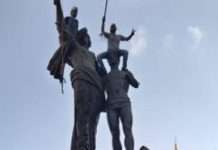Lebanon Continues to Muddle Through
David Schenker/Washington Institute
April 14, 2015
Washington’s efforts to increase security assistance are helpful, but Lebanon will remain a priority target for ISIS and other Sunni terrorist groups so long as Hezbollah continues fighting for the Assad regime in Syria.
On March 31, Lebanese prime minister Tammam Salam was in Kuwait attending a UN humanitarian relief conference for Syria, seeking a billion dollars in assistance to defray Beirut’s costs for hosting more than a million Syrian refugees.
A week earlier, Interior Minister Nohad Machnouk visited Washington in search of additional U.S. funding to help the Internal Security Forces (ISF) better contend with the threat posed by the “Islamic State”/ISIS and other Sunni militant groups.
Taken together, these tin-cup missions highlight the ongoing challenge to Lebanon’s stability as the war in Syria enters its fifth year. Meanwhile, it is unclear whether and how the recently announced nuclear framework with Iran will affect the tenuous calm in Beirut.
COPING WITH REFUGEES
According to the Office of the UN High Commissioner for Refugees, an estimated 1.8 million displaced Syrians have entered Lebanon since 2011. Prior to the war, Lebanon’s population was just 4.5 million, so the refugee influx has made it the fastest-growing state in the world.
The fighting next door has also stymied the Lebanese economy, a problem exacerbated by the state’s extremely high public debt of $75 billion, equivalent to 120 percent of GDP. Lebanon’s public utilities infrastructure and already-stressed finances are under increasing strain, with public services costs rising by $1.1 billion last year alone, according to the World Bank.
Prime Minister Salam emerged from Kuwait with just $118 million in U.S. grants, but he is ultimately hoping to get 37 percent of the $3.8 billion pledged at the conference for all affected countries. How much of these pledges will actually be delivered — and how much will subsequently be earmarked for Lebanon — remains to be seen.
SECURITY PRIORITY
Amid these problems, the Lebanese Armed Forces (LAF) and the ISF have been taxed by continuous domestic incidents. Since ISIS launched an offensive last summer in the border town of Arsal and kidnapped nearly two dozen Lebanese security officials, an estimated 3,000-5,000 ISIS fighters have reportedly been stationed along the state’s northeast frontier. Abductions of Lebanese soldiers and civilians remain commonplace throughout the country, as do attacks against LAF personnel and local policemen. Numerous terrorist operations by ISIS and Syria-based al-Qaeda affiliate Jabhat al-Nusra (JN) have targeted civilians as well.
To some degree, Sunni militants have focused on Lebanese Alawites, local supporters of Syria’s Bashar al-Assad regime, which has killed tens of thousands of mostly Sunni Muslims since 2011. This January, for example, JN claimed responsibility for tandem suicide bombings in the Jabal Mohsen neighborhood of Tripoli that killed nine Alawites. But ISIS and JN’s primary target in Lebanon is the Iranian-backed Shiite militia Hezbollah, which has deployed forces to Syria in support of Assad. Both groups have declared jihad on Hezbollah, and in 2013-2014 they detonated a series of car bombs in militia-controlled areas.
While improved border security measures have at least temporarily diminished the frequency of these attacks, they remain a considerable concern. As Machnouk told al-Sharq al-Awsat in March, explosions and assassinations are likely to occur again. At the same time, he said, the situation in Lebanon is more secure than elsewhere in the region because there is domestic consensus on fighting Sunni extremism (i.e., cooperation between Beirut and Hezbollah) as well as agreement between Saudi Arabia and Iran to keep Lebanon stable.
The United States is also assisting in this regard. In addition to the $75 million in Foreign Military Financing provided to the LAF in 2014, Washington gave $14 million to the ISF. And during his March visit, Machnouk met with senior officials from the CIA, State Department, and Department of Homeland Security, seeking to tap into funding from State’s “Nonproliferation, Anti-terrorism, Demining, and Related Programs” (NADR) war chest.
HEZBOLLAH’S POSTURE
Four years into the war, the Shiite militia remains deeply involved in Syria. As Israel’s January airstrike in the Golan Heights — which killed several top Hezbollah officials and an Iranian general — suggests, the organization is also taking preliminary steps to establish a base of operations for targeting Israel from Syria. In addition, it is devoting significant resources to protecting its infrastructure and the Shiite community at home. Although the militia appears to be spread thin, it shows no sign of retreating from any of these initiatives.
Meanwhile, Hezbollah officials have barely been able to contain their optimism about the framework nuclear parameters that U.S.-led negotiators have tentatively reached with Iran. On April 3, Hezbollah parliamentarian Nawar Sahili described the announced terms as “a global recognition of Iran as a member of the nuclear club.” The next day, Naim Qassem, deputy to Hezbollah secretary-general Hassan Nasrallah, called it “a victory for the right, fortitude, and the will of free peoples and the resistance plan led by Iran, Islam, and the rejection of subordination to the West.” And in an April 6 interview with Syrian television, Nasrallah focused on the benefits Iran would accrue should a deal be inked: “If $120 billion was given back to Iran, what would it do with it? [Iran] would become much more powerful, stronger, and richer, and its influence [in the region] would obviously increase.”
Some commentators in Lebanon and the West have suggested that Hezbollah is concerned a nuclear deal would eventually curtail Tehran’s decades-long support for regionally destabilizing behavior. Yet a similar argument was articulated six years ago when the Obama administration pledged to engage Assad in an effort to split Damascus from Iran. When the author raised this prospect with a senior Hezbollah member during a 2008 visit to Beirut, the official only chuckled. Machnouk articulated the dominant view in Lebanon and the rest of the region during an April 2 interview with LBCI Television — echoing Nasrallah’s assessment, he argued that lifting sanctions would “provide the Iranian government with more money and resources to increase its intervention and influence in the region.”
U.S. POLICY
Since 2007, the United States has provided the ISF with over $100 million in support, including equipment and training for over 8,000 officers. The administration has also asked Congress to approve $80 million in funding for the LAF for fiscal year 2015. And earlier this year, it delivered $25 million in equipment — including howitzers, Humvees, and millions of artillery and rifle rounds — “to help Lebanon’s brave soldiers in their confrontation with terrorists.” Meanwhile, the administration has boosted its already close counterterrorism cooperation with the ISF and LAF against Sunni militants. Along these lines, it was reported late last month that U.S. Special Forces were flying their own reconnaissance drones over Lebanon. Machnouk’s top-level access during his Washington visit attests to how important the administration considers Lebanon’s fight against Sunni extremists.
At the same time, however, Washington appears less concerned about Shiite militancy and its impact on Lebanon’s stability. Hezbollah’s ongoing participation in Syria is increasingly making Lebanon a target of Sunni militants, as is the apparent cooperation/deconfliction between Hezbollah and Beirut in the domestic fight against ISIS. Dozens of cells and attempted attacks have been interdicted in recent months, but some of these operations will inevitably succeed, fueling sectarian tensions. Fears of ISIS and JN sleeper cells are becoming a preoccupation with the Lebanese public. Regrettably, as long as Hezbollah is fighting on Assad’s side, Lebanon will remain a priority target of these groups.
Given the Obama administration’s tacit coordination with Iran against ISIS and its aversion to hitting any Assad-related targets in the air campaign in Syria, Washington is unlikely to take any near-term steps toward curtailing Hezbollah involvement there. If the recently announced cancellation of State Department Middle East Partnership Initiative funding for “independent” non-Hezbollah Shiites is any indication, the administration has also given up on trying to influence, even marginally, developments within Lebanon’s Shiite community. Adding to the sense of uncertainty is the impending early departure of U.S. ambassador David Hale, an experienced Lebanon hand who has served in Beirut since 2013.
To be sure, ongoing US security assistance — along with $3 billion in Saudi defense-related funding — will help the Lebanese security apparatus better contend with the terrorist threat. With no end in sight to the war next door, however, it is just a matter of time until ISIS and JN strike again. Absent any political momentum, but armed with a national consensus against escalation at home, a historically resilient Lebanon will continue to muddle through for the foreseeable future.
David Schenker is the Aufzien Fellow and director of the Program on Arab Politics at The Washington Institute.




















